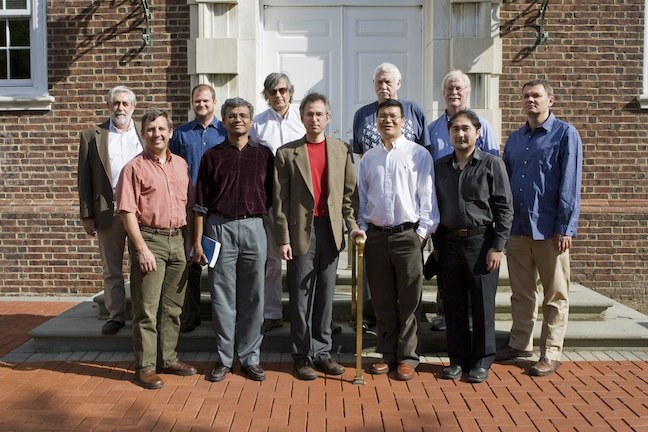Background
Chimera: Background
The machine was purchased with a grant from the National Science Foundation awarded to a team of researchers at the University of Delaware. It will be used to develop new scientific algorithms that can scale to thousands of processors.
Back row: David Saunders, Martin Swany, Krzysztof Szalewicz, A. Dennis Kirwan, James Kirby, Branislav Nikolic
Front row: Louis Rossi, Kausik Sarkar, Stephen Siegel, Lian-Ping Wang, Tian-Jian (Tom) Hsu
Not shown: Peter Monk, Bruce Lipphardt
- Full Resolution Pictures
Award Details
- Award CNS-0958512
- Project Title: "II-New: System Acquisition for the Development of Scalable Parallel Algorithms for Scientific Computing"
- Total award amount: $749,769
- Project Personnel
- Stephen F. Siegel (PI), Dept. of Computer & Information Sciences and Dept. of Mathematical Sciences
- Peter B. Monk (co-PI), Dept. of Mathematical Sciences
- D. Martin Swany (co-PI), Dept. of Computer & Information Sciences
- Krzysztof Szalewicz (co-PI), Dept. of Physics & Astronomy and Dept. of Chemistry & Biochemistry
- Tian-Jian (Tom) Hsu (Senior Personnel), Dept. of Civil & Environmental Engineering
- James T. Kirby (Senior Personnel), Center for Applied Coastal Research and Dept. of Civil & Environmental Engineering
- A. Dennis Kirwan (Senior Personnel), School of Marine Science and Policy
- Bruce L. Lipphardt (Senior Personnel), Jr., College of Earth, Ocean, and Environment
- Branislav K. Nikolic (Senior Personnel), Dept. of Physics & Astronomy
- Louis F. Rossi (Senior Personnel), Dept. of Mathematical Sciences
- Kausik Sarkar (Senior Personnel), Dept. of Mechanical Engineering
- B. David Saunders (Senior Personnel), Dept. of Computer & Information Sciences
- Lian-Ping Wang (Senior Personnel), Dept. of Mechanical Engineering
Project Abstract
Parallel computing now plays a central role in nearly every science and engineering endeavor. The leading supercomputers today comprise hundreds of thousands of processors, and in the near future are expected to comprise millions of processors. Researchers at the University of Delaware are working to harness this vast computing power to make ground-breaking scientific discoveries. This work will require fundamental algorithmic research and development to address issues such as multiscale coupling, scalability, and hybrid message-passing/threaded programming.
The investigators are building a new, highly parallel, computing system for scientific computation research and teaching at the University of Delaware. This computer will comprise over 3000 processors, and will be expandable to many more. It will be used by UD researchers who share a common interest in scalable parallel computation to explore a variety of scientific applications: 3D Navier-Stokes solvers for environmental turbulent flows; "ensemble analysis" in oceanic forecasting; computational electromagnetism; simulation of emulsion microstructure for environmental pollution control and material synthesis; electronic structure calculations for atoms and molecules; multiscale cloud dynamics for more reliable weather and climate prediction; computational carbon nanoelectronics; and vorticity-dominated flows. The new computer will be used to optimize the current algorithms in each application, help identify limitations to scalability, and explore new ideas to enable scaling to hundreds of thousands of processors and to take advantage of hybrid architectures. The system will also motivate collaboration among faculty interested in application problems and faculty with expertise in computer science. Libraries for efficient parallel data redistribution and automatic optimization of parallel codes are some of the ways the computer scientists participating in the project are enhancing the scientific applications.
